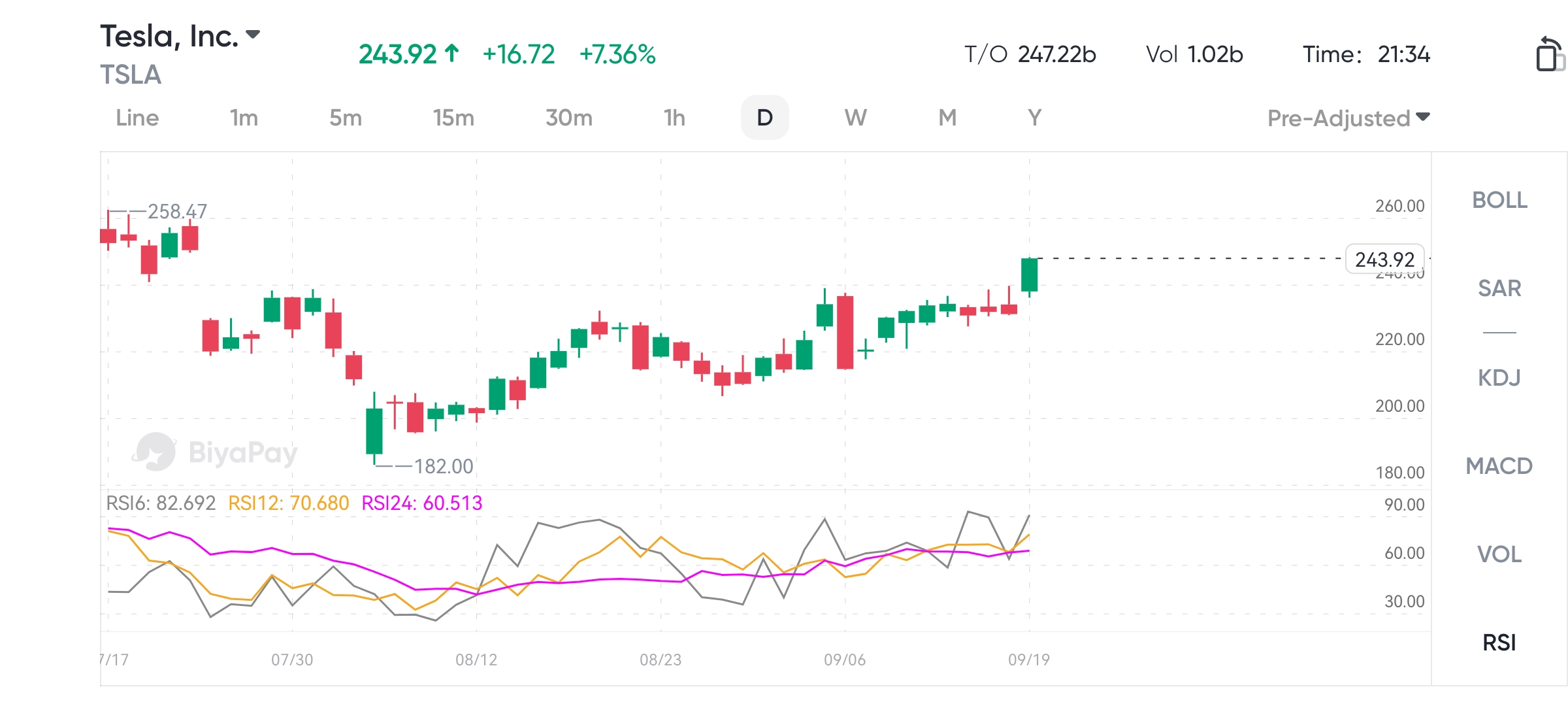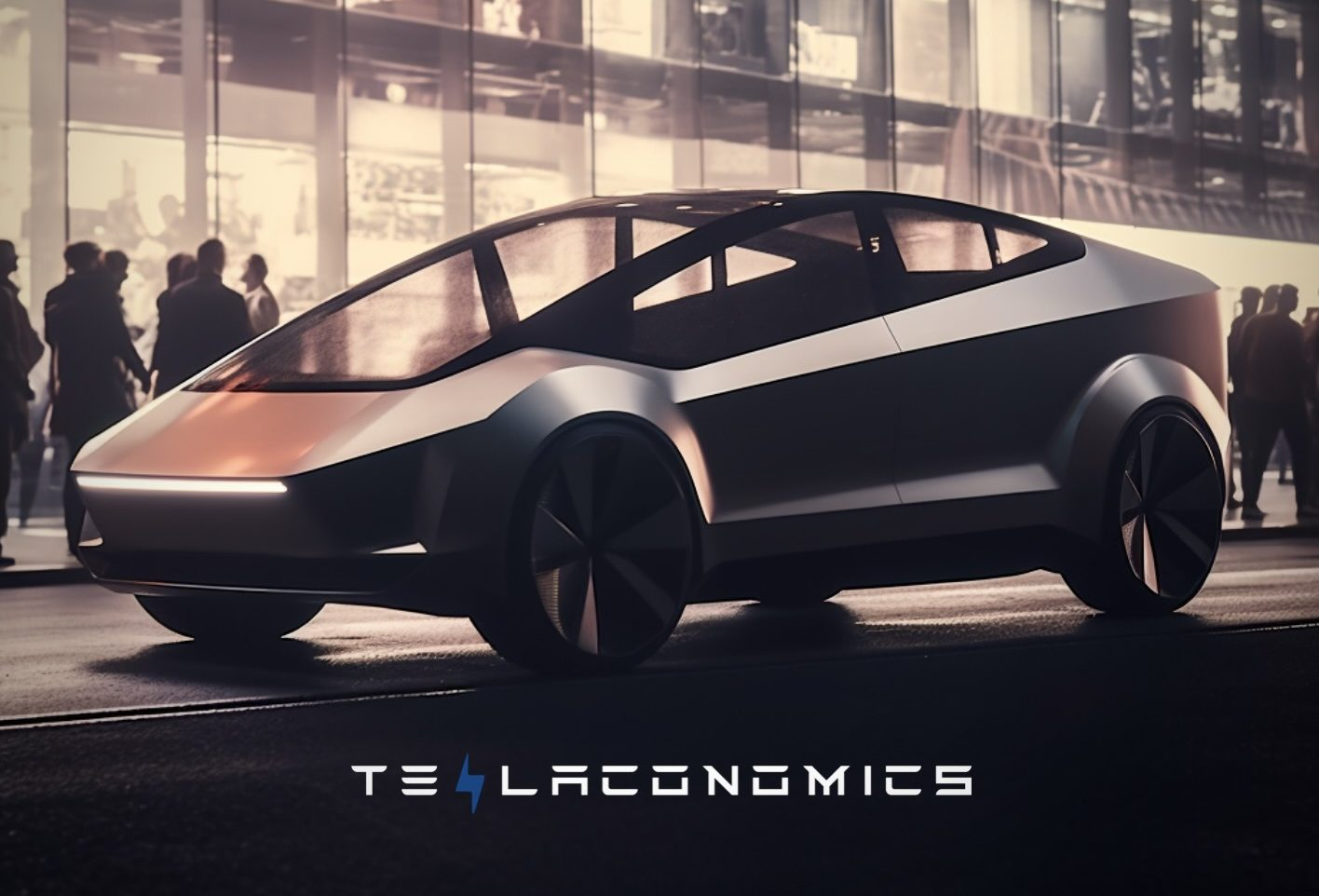- Remittance
- Exchange Rate
- Stock
- Events
- EasyCard
- More
- Download
TSLA surges over 7% as Robotaxi nears launch, boosting bullish sentiment. How much growth potential
On Thursday local time, Tesla closed up 7.36%, hitting a new high in nearly two months with a trading volume of $24.70 billion and a total market value of $779.20 billion, which has attracted widespread market attention. The surge is closely related to the high expectations of the upcoming Robotaxi unveiling ceremony. Wall Street analysts are optimistic about Tesla’s future, especially its potential in the fields of autonomous driving and Robotaxi, and this optimism has driven up the stock prices.

Why did Tesla’s stock price rise sharply?
The recent rise in Tesla’s stock price is not accidental, driven by multiple factors. From the upcoming Robotaxi unveiling ceremony to positive comments on Wall Street, Tesla’s future development prospects are attracting widespread attention.
Robotaxi unveiling ceremony sparks market expectations
The sharp rise in Tesla’s stock price this time is largely due to the high expectations of the market for the unveiling ceremony of Robotaxi. As the core of Tesla’s fully autonomous driving strategy, the launch of Robotaxi marks a key step in the company’s transformation from an electric vehicle manufacturer to an autonomous driving service provider. Investors generally believe that Robotaxi will open up a new market for Tesla and greatly enhance its revenue potential.
Robotaxi is not only a new product of Tesla, but also an important application of the company’s FSD (fully autonomous driving) technology. Tesla’s FSD technology has made significant progress, and Robotaxi will be the first large-scale monetization attempt of this technology. This has made the market confident in Tesla’s future leadership position in the field of autonomous driving, further driving up the stock price.
Macroeconomic and market environment support
In addition to Tesla’s own technological progress, the macroeconomic environment has also provided favorable conditions for its stock price to rise. With the increasing expectation of gradual interest rate cuts by the Federal Reserve, the market’s interest in high-risk technology stocks has rebounded, and Tesla, as a leader among them, naturally benefits from this trend. Lower interest rates not only help consumers more easily obtain car loans, but also provide a more optimistic market environment for the future growth expectations of technology companies.
Why is Robotaxi expected to become a growth catalyst?
In Tesla’s future growth strategy, the Robotaxi project is seen as an important catalyst. With the continuous advancement of fully autonomous driving technology, this project will not only change people’s travel methods, but also bring new sources of revenue to Tesla, and is expected to become a new growth catalyst.

The market prospect of the Robotaxi project
The Robotaxi project is seen as an important step for Tesla to move towards a future transportation revolution. Based on Tesla’s fully autonomous driving (FSD) technology, the project will provide users with unmanned shared transportation services. This is not only a technological breakthrough, but also a transformation of the business model, which is expected to have a disruptive impact on the global transportation market.
Relevant institutions predict that the market potential of Robotaxi is huge, and the global market size may reach trillions of dollars. As a leader in autonomous driving technology, Tesla is expected to dominate this emerging field. With the launch of Robotaxi, Tesla will have the ability to change people’s travel methods and provide more convenient and cost-effective transportation options. This new service model will also bring long-term recurring revenue to Tesla, thereby improving its overall profitability.
The business model and profit prospects of Robotaxi
The business model of Robotaxi includes various possible ways: Tesla can operate Robotaxi through its own fleet, cooperate with third-party platforms (such as Uber), or even establish joint ventures with fleet operators. In addition, Tesla’s FSD subscription service may also be closely integrated with Robotaxi to provide consumers with more personalized choices.
It is expected that the cost per mile of Robotaxi will be slightly higher than that of traditional shared travel services in the early stage of monetization. However, as the technology matures and operating costs decrease, the cost per mile of Robotaxi will gradually decrease, and Tesla will also obtain higher gross profit margins from it. In the long run, the Robotaxi business is expected to bring considerable recurring income to Tesla, further supporting its stock price rise.
Competitive advantage and differentiation
Tesla’s Robotaxi project has significant competitive advantages compared to other autonomous driving companies such as Waymo and Uber. Firstly, Tesla’s vertically integrated model enables it to control all aspects of vehicle manufacturing, hardware, software, and autonomous driving technology. This model not only reduces production and operating costs, but also enables Tesla to respond more flexibly to market demand.
In contrast, Waymo’s autonomous car costs over $100,000, while Tesla’s manufacturing cost is less than $40,000. As Tesla launches lower-cost models such as Model 2, the cost advantage of Robotaxi will be further highlighted. In addition, Tesla’s FSD system relies on vision technology rather than expensive LiDAR, making its technology more cost-effective. This strategy helps Tesla maintain higher market competitiveness in the fields of autonomous driving and shared mobility.
Tesla’s FSD technology achieves end-to-end autonomous driving through AI neural networks training, which increases its potential for deploying Robotaxis globally. In the future, with the continuous maturity of FSD technology and the gradual relaxation of regulations, the Robotaxi business is expected to expand in multiple countries and regions, further promoting Tesla’s growth.
What other growth advantages does Tesla have?
Apart from the Robotaxi project, Tesla’s other businesses and strategic layout also provide strong support for its future growth. With the continuous expansion of the electric vehicle market, Tesla’s expansion in new energy and artificial intelligence will bring new growth momentum to the company.
The potential of new energy and energy storage businesses
In addition to electric vehicles and autonomous driving businesses, Tesla’s layout in the new energy and energy storage fields also provides strong support for its future growth. Tesla’s energy business, including solar products and energy storage systems (such as Powerwall and Megapack), is gradually becoming the company’s new growth engine. As countries around the world accelerate the use of Renewable Energy, the demand for energy storage has surged, and Tesla’s energy storage system has shown great potential in the grid and home energy storage markets.
These products not only provide power reserves for users, but also help balance the power grid and reduce energy costs. Tesla is expanding its energy storage business in multiple regions around the world, further enriching its revenue sources. With the acceleration of energy transformation, the energy storage business will become an important part of Tesla’s diversification strategy, bringing long-term sustainable profit growth to the company.
Layout of artificial intelligence and supercomputing
Tesla not only applies artificial intelligence in autonomous driving technology, but also promotes the development of its AI technology by building its own supercomputing cluster “Dojo”. Dojo will be used to train Tesla’s FSD neural networks and improve the vehicle’s autonomous driving ability. In addition, Tesla’s AI layout may bring more innovative applications in the future, such as intelligent factory management and robotics technology. Optimus humanoid robot is an important embodiment of this strategy, and Tesla hopes to promote the large-scale commercial use of these products through AI technology.

With the continuous expansion of AI applications in various industries, Tesla is not only expected to have an advantage in the field of autonomous driving, but also may enter more new markets through AI technology, further enhancing its growth potential.
Launch of new models such as Cybertruck and Semi
Tesla’s upcoming two heavyweight models, Cybertruck and Semi truck, are expected to bring significant revenue growth to the company. Cybertruck, as an innovative electric pickup truck, has attracted a large number of orders worldwide, especially in the North American market. Semi trucks will push Tesla into the electric commercial vehicle field and help solve the carbon emission problem in logistics transportation. These new models are not only an expansion of Tesla’s existing product line, but also a key step for the company to expand in the high-end market and commercial field.
The expansion of the global electric vehicle market
Tesla’s position in the global electric vehicle market remains solid, especially in core markets such as the US, Europe, and China. Despite competition from BYD, NIO, and other manufacturers, Tesla continues to maintain its leading position in the market with its strong brand influence and technological advantages. Tesla’s best-selling models such as Model 3 and Model Y still have strong demand worldwide, supporting the company’s stable sales growth. With Tesla’s expansion in new markets and capacity improvement, revenue growth in the coming years will continue to be guaranteed.
Analysis of Tesla’s stock price trend: How much more can it rise?
As the potential of Robotaxi and other businesses gradually emerges, investors cannot help but ask: How much more can Tesla’s stock price continue to rise? Wall Street’s optimistic expectations and market analysis provide different perspectives on this issue.
Wall Street’s optimistic expectations
Recently, institutions such as Morgan Stanley and Deutsche Bank have expressed positive views on Tesla’s stock price. Morgan Stanley has set Tesla’s target price at $310, believing that Robotaxi will bring significant revenue growth to the company. Deutsche Bank is also confident in Tesla’s future development and expects its stock price to rise significantly in the next 12 months.
In addition, famous investor Cathie Wood is also optimistic about Tesla. She predicts that the Robotaxi market may bring revenue opportunities of up to $8 to $10 trillion, and Tesla is expected to occupy half of the market share. These optimistic predictions not only reflect the market’s confidence in Tesla’s future potential, but also provide strong support for the stock price to rise.
Valuation and Price-To-Earnings Ratio Analysis
In terms of valuation, Tesla’s Price-To-Earnings Ratio indicates weak long-term growth potential. The expected Price-To-Earnings Ratio is 96.92, far higher than the industry median of 15.79, with a premium of 514%. Tesla’s short-term leading position in the electric vehicle market proves that a certain premium is reasonable, but not yet to this level. Crucially, the company’s Price-To-Earnings Ratio is only 15% lower than its five-year average of 114.1, which limits the potential upward space for profit decline in the coming quarters.
Tesla’s PEG ratio (Price-To-Earnings Ratio to Growth Rate) is 8.93, indicating high market expectations for its future profit growth. However, this also means that the upward space for the stock price may be limited. Nevertheless, Tesla’s continued innovation and diversified development strategy will provide momentum for its future stock price.
Long-term stock price growth potential
Considering multiple growth factors such as Robotaxi, AI technology, energy business, and new vehicle launches, Tesla has strong growth potential in the next few years. Investors generally expect Tesla’s stock price to climb above $300 in the next 12 months, and with the improvement of market environment and technological advancements, this goal is not out of reach.
It is expected that Tesla’s profitability will further enhance around 2025, and the stock price is expected to return to the high point of 2021. This expectation is based on the company’s sustained development and growth potential in multiple key areas, reflecting the market’s optimistic attitude towards Tesla’s future.
Although it has growth potential, the risks cannot be ignored
Although Tesla has shown strong growth potential in multiple areas, it still faces a series of risks and challenges in achieving these goals.
Technical and regulatory barriers
Tesla’s Fully Autonomous Driving (FSD) technology has made significant progress, but it still faces many technical and regulatory obstacles to global promotion. Governments have different regulatory policies for autonomous cars, which may affect the market access and promotion speed of Robotaxis. In addition, the maturity of FSD technology is also a challenge that cannot be ignored. Tesla needs to ensure the safety and reliability of its technology in various complex environments in order to gain widespread market recognition.
The approval process of regulatory agencies is often slow and complex, especially in the field of autonomous driving technology involving public safety. If Tesla cannot solve these problems within a reasonable time, it may delay the launch of Robotaxi, thereby affecting the company’s revenue and stock price performance.
Intensified market competition
Tesla’s leading position in the electric vehicle market is being challenged by more and more competitors. Especially in the Chinese market, local brands such as BYD and NIO are rapidly rising, posing a direct threat to Tesla. These manufacturers not only have competitiveness in technology and price, but also have advantages in policy support and market adaptability.
In addition, other international brands such as Ford and General Motors are also increasing their investment and layout in the electric vehicle market. Tesla needs to maintain its leading position in technology and brand to cope with the increasingly fierce market competition. If Tesla fails to effectively respond to these competitive pressures, its market share may be eroded, thereby affecting its stock price and profitability.
Financial performance fluctuations and economic uncertainty
Tesla’s financial performance is influenced by various factors, including production costs, supply chain issues, and market demand fluctuations. The uncertainty of the global economy, especially inflation and rising interest rates, may affect consumers’ purchasing power, thereby affecting the sales of electric vehicles.
In addition, Tesla may also face challenges in the production and delivery process of new models, such as whether the capacity of Cybertruck can meet market demand and the monetization process of Semi trucks. These factors may cause financial performance fluctuations, thereby affecting investors’ confidence in Tesla’s stock price.
How should investors layout?
With Tesla’s strong growth potential in the market, investors’ attention to its future continues to rise. However, while seizing opportunities, a reasonable layout strategy is particularly important. Here are some suggestions to help everyone better cope with Tesla’s stock price fluctuations.
Investors can pay attention to the market sentiment changes brought about by the Robotaxi unveiling ceremony and other major events. In the short term, Tesla’s stock price may be affected by market speculation and mood swings, so timely entry or exit is crucial. If the market’s reaction to the Robotaxi release is too optimistic, the stock price may rise rapidly in the short term, and investors can consider making profits at this time.
However, investors should also be wary of the situation of “buying rumors and selling facts”. If the release of Robotaxi fails to meet market expectations, the stock price may experience a sharp decline. Therefore, it is crucial to maintain a flexible and cautious investment strategy, and adjust positions in a timely manner to respond to sudden changes.
For long-term investors, Tesla’s continued development potential in multiple fields such as electric vehicles, autonomous driving, energy storage, and AI is worth paying attention to. Investors should view Tesla as a diversified technology platform and focus on the comprehensive growth of its various businesses, rather than just short-term fluctuations in electric vehicle sales.
Regularly evaluating Tesla’s financial performance and market dynamics, and making strategic investments in conjunction with new vehicle launches and technological advancements, can effectively reduce risks. In the long run, Tesla’s leadership position in the electric vehicle and energy markets and its continued innovation capabilities will bring considerable returns to its shareholders.
Given the investment prospects, investors can pay attention to the market in a timely manner and find the right time to buy. Specifically, you can go to BiyaPay to monitor the trend of Tesla’s market and choose the appropriate time to buy. In addition, if you encounter difficulties in deposit and withdrawal, BiyaPay can also serve as a professional tool for depositing and withdrawing funds from US and Hong Kong stocks. You can exchange digital currency for US dollars or Hong Kong dollars, quickly withdraw to your bank account, and then transfer the funds to other brokerage accounts to buy stocks. The platform has a fast and unlimited arrival speed, which will not let you miss investment opportunities.
Despite Tesla’s huge future growth potential, its current high valuation still needs to be treated with caution. Investors can consider diversifying their investments to reduce dependence on a single stock and reduce latent risk. In addition, regular small investments (such as regular investments) are an effective strategy to deal with high valuations, which can smooth costs in different market environments and reduce the impact of short-term fluctuations.
At the same time, investors should also maintain sensitivity to market changes, closely monitor economic data, industry trends, and competitive dynamics, and adjust investment strategies in a timely manner to adapt to the constantly changing market environment.
Overall, Tesla’s strong growth potential in the fields of electric vehicles and autonomous driving, especially the upcoming launch of Robotaxi, has filled the market with anticipation. Despite facing multiple challenges such as technology, competition, and economics, Tesla still has the foundation for long-term growth with its innovative capabilities and diversified strategy. Investors should pay attention to market dynamics, flexible layout, seize Tesla’s future development opportunities, and achieve sustainable investment returns.

























